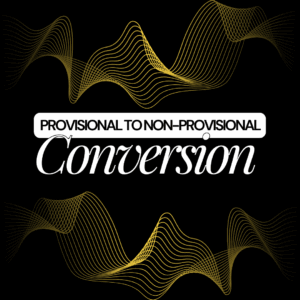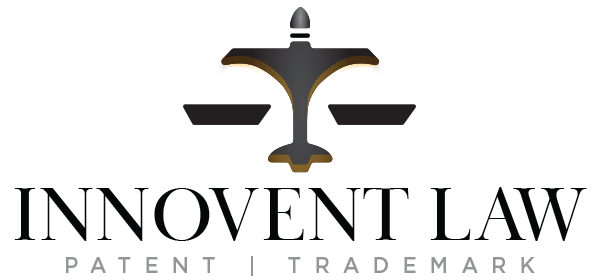Provisional to Non-Provisional Conversions: What Every Entrepreneur and Startups Must Know
Thinking of protecting your invention? Starting with a provisional patent is a smart move. But don’t stop there. To receive full patent protection, you must convert that provisional to a non-provisional patent within 12 months. Here’s everything you need to know to protect your innovation and avoid losing rights.

Why Entrepreneurs Start With a Provisional
A provisional application is a lower-cost way to secure a filing date while developing your invention. It’s informal, doesn’t require claims, and isn’t examined by the USPTO. However, it expires 12 months after filing unless it’s converted to a non-provisional application. Missing this deadline means losing your priority date.
Learn more about Utility Patents.
For startups and entrepreneurs, a provisional patent offers flexibility, speed, and lower upfront costs. It’s the smart first step when:
- You’re still refining your invention
- You need time to assess market potential
- You’re pitching to investors but want to secure your idea
- You want to mark your invention as “patent pending”
A provisional application gives you 12 months of breathing room to develop, test, and present your invention while securing an early filing date. This date becomes your priority if you convert to a non-provisional patent on time.
What Is a Non-Provisional Patent?
A non-provisional patent application is the formal filing that begins the examination process with the USPTO. It must include claims, an oath or declaration, and formal drawings. Once filed, the application will be reviewed by a patent examiner.
Review the full Patent Application Process.
Why Converting Matters
Without converting, your provisional becomes worthless. You lose your early filing date and potentially your patent rights. A timely provisional to non-provisional conversion preserves your priority date and positions your invention for enforceable protection.
When Should You Convert?
Start preparing to convert as soon as your invention is commercially viable. Don’t wait until the last minute. Ideally, file your non-provisional application six to ten months after the provisional filing.
The Strategy Behind It
Entrepreneurs often use the provisional-to-non-provisional strategy as part of their product launch plan. Here’s why it works:
- Speed to Market: You can launch your MVP or demo while still developing the full invention.
- Investor Confidence: “Patent pending” signals that you’re serious about protecting IP, which builds trust.
- Financial Flexibility: You defer the higher cost of a full non-provisional while raising capital or validating your concept.
- Time for R&D: If you’re still refining features, a provisional gives you time to improve the invention before locking in claims.
But the key is not to wait too long. You must convert within 12 months to keep your rights intact.
Common Mistakes When Converting
Avoid these missteps:
- Missing the 12-month deadline
- Failing to include enough detail in the original provisional
- Not consulting with a patent lawyer
- Relying on vague language or skipping professional drawings
Explore 5 Common Patent Mistakes.
What You Need to Convert
When converting, you’ll need:
- A completed and detailed specification
- Formal patent drawings
- At least one claim
- USPTO filing fees
- A signed oath or declaration
What Happens During the Patent Process?
Once filed, the non-provisional patent application enters the queue for examination. You may receive an office action requiring revisions or arguments. Work with an experienced attorney to respond quickly and accurately.
Learn about Patent Office Actions.
Timeline to Keep in Mind
- Provisional filed: Day 1
- Ideal conversion window: 6 to 10 months
- Absolute conversion deadline: 12 months
- Review period: Weeks to months after non-provisional is filed
Missing the deadline? You might still have options, but they’re limited. Act fast.
Should You File a New Non-Provisional Instead?
In some cases, it may be better to file a new non-provisional application instead of converting. Why? If you’ve significantly changed the invention since the provisional was filed, a new filing might better protect your updated version.
Working With a Patent Lawyer
The transition from provisional to non-provisional is not just about filing paperwork. It’s about making sure your patent:
- Covers the right claims
- Avoids unnecessary delays
- Has solid legal protection
Our California Patent Registration Team can guide you.
Budgeting for Your Patent Conversion
A typical conversion includes attorney fees and USPTO filing fees. Fees vary depending on the size of your entity, the complexity of the invention, and how many claims you include.
For a transparent breakdown, visit our Patent Pricing Page.
The Role of Drawings in Your Conversion
Patent drawings are essential. They illustrate how your invention works and clarify technical details for the examiner. Whether you’re converting to a utility or design patent, visuals are part of the strategy.
Read: Patent Drawings Checklist
What If You Filed with Another Attorney?
No problem. We frequently take over files from other firms to complete or improve your applications. We’ll assess the strength of your original provisional and help you build a strong non-provisional application from it.
Don’t Forget: You Can Monetize Your Patent
Once granted, a patent opens the door to licensing deals, partnerships, and new revenue streams. Converting your provisional is the first step toward that return on investment.
Explore How to Monetize Your Patent.
Summary: Your Provisional to Non-Provisional Checklist
- ✅ Confirm your 12-month deadline
- ✅ Gather updated specs and drawings
- ✅ Identify what’s changed since the provisional
- ✅ Draft strong claims with your attorney
- ✅ Prepare USPTO forms and fees
- ✅ File and monitor your application
- ✅ Respond to office actions
